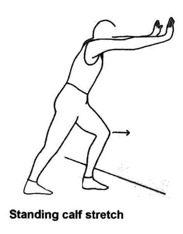Happy feet
The bad news is you have to ditch those high heels!
 Janet Ng (not her real name) loves high heels, and wore them throughout her teaching career. Standing in uncomfortable heels hour after hour took a toll on her feet, and by the time she retired, she had developed severe bunions. These bumps, which form on the joint at the base of the big toe, prevented her from standing or walking comfortably, a condition that experts say is common.
Janet Ng (not her real name) loves high heels, and wore them throughout her teaching career. Standing in uncomfortable heels hour after hour took a toll on her feet, and by the time she retired, she had developed severe bunions. These bumps, which form on the joint at the base of the big toe, prevented her from standing or walking comfortably, a condition that experts say is common.
Manfred Mak Yaoquan, a podiatrist in the Department of Podiatry, Singapore General Hospital (SGH), said: “Many of our patients with foot problems are women who have either been wearing high heels for prolonged periods or have been forcing their feet into ill-fitting shoes. Often, vanity is the main cause.”
According to Mak, who sees about 50 women every month for high-heel-related problems, an increasing number of younger women, some in their late 20s, are getting treatment for problems like bunions, heel spurs and hard skin on their feet. “High heels are not good for feet. If you have to wear them, the maximum heel height should be one to two inches,” he said.
Squeezing broad feet into shoes that are too narrow is also not advisable. Many women believe that blisters are a natural consequence of the “breaking-in” process for new shoes, but Mak said these should not continue to form after the second or third wear.
If the shoe fits
“Just because your foot can fit into a shoe doesn’t mean it’s a good fit. There are many soft tissues in the foot which shouldn’t be compressed,” said Mak. One way of ensuring a proper fit is to remove the shoe’s insole, put it on a flat surface, and then place the foot over it. If the foot is too large for the insole, the shoe is too small.
Apart from fitting well, a good pair of shoes should also hold the feet down properly with features such as laces, buckles or straps. Elastic bands are not ideal, as they often don’t offer enough support. Often overlooked too is the heel counter, or the back of the shoe, meant for holding the foot in place and providing support while walking. Footwear with a solid back support or firm back strap is recommended – meaning sandals should be chosen over flip-flops for walking. Flip-flops such as Japanese-styled slippers are not recommended for those with diabetes because friction from the toe-grip can injure the area between the toes.
Men have problems too
While many women are guilty of making poor footwear choices, men fall short when it comes to foot hygiene. “Men usually develop fungal infections between their toes because they tend to sweat more and don’t dry their feet properly. They also often neglect to change their socks daily,” said Mak. He also had a word of caution for women who visit nail salons. “If, for instance, instruments used in nail salons are not cleaned properly, fungus spores and bacteria can spread easily from one customer to the next,” he said.
Ultimately, personal foot hygiene and good foot health are one’s own responsibility. For a start, change socks daily, moisturise dry spots and choose footwear that fits well. While it may be counterintuitive for many women, “common sense and not vanity should prevail to ensure good foot health,” said Mak.
Common foot conditions
• Athlete’s Foot – The fungus that causes Athlete’s Foot can cause skin to become itchy and sore, then start to crack and peel. Worsened by poor foot hygiene, Athlete’s Foot can be picked up from floors where people are likely to walk around barefoot, such as in locker rooms, swimming pools and nail salons. SOLUTION: There are over-the-counter Athlete’s Foot treatments. You can consult the pharmacist on the right one for you, or see your doctor or podiatrist for advice.
• Calluses – Calluses are areas of thickened skin caused by repeated friction and pressure, and commonly affect the heel and sides of toes. People with flat feet are prone to calluses, especially on the balls of their feet and the insides of their heels, as their abnormally low foot arches cause excessive pressure on these areas. Going barefoot often or wearing poorly fitting shoes can also be contributing factors. Left untreated, calluses can develop a mass of dead cells in their centre, leading to corns. SOLUTION: Again there are over-the-counter treatments for calluses. You might want to use a pumice stone and foot file to reduce the thickened skin.
• Heel spur – An abnormal growth of the heel bone (bony protrusion) largely due to calcium deposits, heel spurs can cause great pain when standing or walking. Those with flat feet, unusually high foot arches or women who regularly wear high heels are prone to this condition. SOLUTION: Short-term rest, inflammation control and wearing an appropriate footwear or insoles.
• Bunion – An abnormal enlargement of the joint at the base of the big toe, a bunion often causes the joint to stick out and the big toe to lean towards the second toe, resulting in pain and soreness. Wearing high heels, shoes that crowd the toes and spending long periods on one’s feet can aggravate the situation. SOLUTION: Treatment can include change of shoes, orthotics, rest, ice and medications to surgery to address the deformity.
(Information has been provided by Manfred Mak Yaoquan, SGH)
Choosing the right pair of shoes
1. Shoes have to be firm, for instance, the shoe should only be flexible (and bend) at the ball of the feet (at the big toe joint). Shoes that are able to bend in the middle portion often do not offer sufficient support for the foot.
2. For closed-in shoes, there should be sufficient space (length, width and depth, in the front of the shoes (toe box)). Toes should not be squashed; the wearer should be able to wriggle his toes and there should be one thumb space in the front, from the longest toe to allow the foot to extend during walking/ running. Ask someone to measure this for you while you are standing obtain an accurate measurement.
3. A raised and curved arch with adequate depth in the shoe (foot is not ‘falling’ out of shoe).
4. Purpose/function of shoes – what is the shoe being used for? For example, for sports, shoes with sufficient cushioning and support are recommended due to an increase in impact forces on the foot. For example, high-heeled shoes are not designed for extended periods of walking and should not be used if you plan to walk a considerable distance.
5. Different makes of shoes come in different lengths and widths. For example: A size 8 Nike is different in length, etc as compared to a size 8 Adidas. Variations can also occur within the brand itself. Therefore, it would be advisable to have your feet measured (whilst standing, not sitting) each time you purchase shoes. As far as possible, avoid asking someone else to buy shoes on your behalf without personally trying out the shoe first. Feet are seldom precisely the same size. The left foot might be slightly larger than the right foot, vice versa. Hence, buy shoes that fit the bigger foot, not the smaller one.
6. Never purchase tight footwear thinking that it will ‘wear in’ and expand after use. Blisters, etc will have already occurred by then.
7. Shop for shoes in the afternoon as feet tend to swell up in the later part of the day.
8. Try walking with both shoes in the shop before purchasing them. Try them on using the similar pairs of socks you intend to wear with them. Shoes should feel comfortable and do not need to be stretched or broken-in to.
(Information has been provided by Manfred Mak Yaoquan, SGH)
 1. Calf stretches – This exercise will help prevent/relief/relax the calf muscles, which would then put less stress on the plantar fascia, thus reducing the common ‘heel pain’ (see below).Exercises that help improve condition of feet
1. Calf stretches – This exercise will help prevent/relief/relax the calf muscles, which would then put less stress on the plantar fascia, thus reducing the common ‘heel pain’ (see below).Exercises that help improve condition of feet
2. Towel stretch – Similar effect to calf stretches, can be performed sitting down. Place towel across ball of one foot and grab the towel at the two ends with your hands. Keep your back straight and pull the towel towards you. Ensure that leg is fully straightened throughout the exercise.
3. Foot rolls – This will be helpful to massage the arch area and the bottom of the foot to relieve aches/pain. For a foot roll, consider using a water bottle that contains ice to reduce inflammation or give a soothing effect at the same time.
4. Marble grabbing – Picking up small, rounded objects (no sharp objects) with your toes can help to strengthen and work the intrinsic muscles of the foot.
5. Ankle circles – Primarily works the lower leg muscles and helps to stretch or strengthen them as well as prevent deep vein thrombosis if seated for long periods of time. You can do this seated, or lying down. Keep leg completely still and circle the foot slowly and as widely as it will go. Do this 3 to 5 times, then circle in the opposite direction. Repeat on the opposite leg.
(Information has been provided by Manfred Mak Yaoquan, SGH)
** Portions of this story was first published in Singapore Health, May/June 2010 (a SingHealth and SGH publication) and has been reprinted with permission from SingHealth and SGH. Special thanks to Manfred Mak Yaoquan and Serene Ng.
(PHOTO CREDITS: Heel picture: ELEGANT STILETTO SHOE © Gabriel Blaj | Dreamstime.com; Standing calf stretch picture: Manfred Mak Yaoquan, SGH)

0 Comments